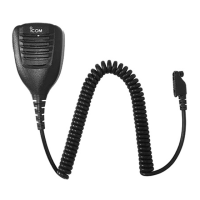PANEL
DESCRIPTION
OPTT
SWITCH
Hold
down
to
transmit;
release
to
receive.
©TOP KEY
(for
HM-170GP/HM-171
GP/HM-175GPS/HM-189GPS
only)
HM-170GP/HM-171GP:
Desired functions can be programmed by your dealer, depending
on connected transceiver
(see
the transceiver's instruction manual).
• Only HM-171GP; Key illumination lights while the HM-171GP is
connected
to
the
transceiver,
then
it
blinks
while
GPS
receiver
receives
GPS
signals.
HM-175GPS/HM-189GPS:
Push
to turn
the
GPS
receiver's
power
ON/OFF.
• Key illumination lights
when
GPS
receiver is ON. Key illumina
tion lights
OFF
when
it's OFF.
• Key illumination blinks while
GPS
receiver receives
GPS
signals.
©GPS
ANTENNA
(forHM-170GP/HM-171GP/HM-175GPS/HM-189GPS only)
Connection
HM-169/HM170GP
•HM-171GP
•HM-184
•
HM-174/HM-175GPS
•HM-189GPS
HM-170GP/HM-171GP/HM-175GPS/HM-189GPS
o-§
Microphone
Belt clip
Connector
HM-169/HM170GP
HM-171GP
7T
HM-174/HM-175GPS
HM-184
HM-189GPS
ATTENTION
FOR
GPS
RECEIVER
(HM-170GP/HM-171
GP/HM-175GPS/HM-189GPS
only)
About
calculating
position
The
GPS
receiver receives signals from
GPS
satellites. It calculates its posi
tion by
the
orbit
information
of
the
GPS
satellites
and
needs
to
measure
the
distance
between
itself
and
three
or
more
GPS
satellites
to
obtain
a
reliable
position. A receiver acquires all available satellites when it is first powered up,
powered oft for a long time, or powered up again at a place a long way from
when it was last powered off. Normally, it
takes
approximately 1 minute for
determining a position.
In
places
where
the
GPS
signals
cannot
reach
the
GPS
receiver
such
as
in
caves,
underground,
indoors,
under
overpasses,
beside
tall buildings, or
near
any
other
devices
that
cause
electronic
interference,
the
GPS
receiver may
show
position
errors
(misplacement)
or no position
reading
at
all.
As the satellites
are
continuously moving,
measurement
of the position or
time by the
GPS
receiver
may
take
a while,
and/or
no position
reading
can
be
made
in
some
instances.
Even
if
the
GPS
receiver
receives
signals
from
three
cr
more
satellites, it
may
take
a
longer
time to
determine
a position
depending
on
the
satellite locations.
Radio wave reception from the satellites is not only blocked by buildings
and
trees,
but
also
by
the
human
body
in
some
instances.
Therefore
the
GPS
antenna
should be kept
as
far away from the body
as
possible for
best
recep
tion.
About
Almanac
and
Ephemeris
Data
To reduce the time for calculating position, the
GPS
receiver
stores
the
Almanac
Data
(the
orbit course-orbital
parameters
of
the
satellites) in its inter
nal memory. When the
GPS
receiver is left with the power OFF for a long time,
the
GPS
receiver
needs
to acquire the Almanac Data again. In this
case,
the
receiver
starts
as
a
"cold"
start.
The
GPS
receiver
stores
Ephemeris
Data
of
the
satellite's
orbital
course,
and
refers
to
this
data
when
the
GPS
receiver
is
turned
OFF
for
a
short
time.
This
is called a "hot"
start,
and
uses
the
Ephemeris
Data
that
is valid to within
less
than
4
hours.
Icom
Inc.
1-1-32 Kamiminami, Hirano-ku,
Osaka
547-0003
Japan
Printed on
recycled
paper
with
soy
ink.
Location
precision
The GPS receiver automatically calculates its position when the GPS receiver
receives
GPS
signals from
three
or more
GPS
satellites.
The
GPS
satellite's
measurement
error
about
±10
meters,
however
this
can
vary up to several hundred meters depending on the surrounding environ
ment.
When the
GPS
receiver is powered up again at a place a long way from when
it was last powered off, the first calculation of its position may be incorrect in
some
cases.
The
GPS
information
and
its accuracy varies
depends
on the
GPS
system
being
acquired,
place
and
time.
Generally a GPS receiver cannot obtain a clear signal from the satellite when
indoors. As a result, the
GPS
receiver may
show
position
data
several hun
dred meters from actual place, or may show no position reading at all.
About
NMEA
sentence
The
GPS
receiver
outputs
the
last
memorized
NMEA
sentence
if the current
position
data
cannot be received
due
to the
GPS
signal being blocked by a
building,
car
roof, etc., or it
takes
a long time to acquire the position data from
a cold
start.
In this
case,
the
NMEA
sentence
information may
also
include
an
"invalid"
Indication.
About
Condensation
Ifcondensation
appears
on the
outer
casing
of the
GPS
speaker
microphone
due to a sudden change in temperature (E.g. brought to a warm room from
a cold place), it is likely
condensation
has
also built-up on the inside of the
microphone. In this
case,
keep
the
microphone with power OFF at room tem
perature for
about
1 hour. Do not turn ON the microphone until the conden
sation
disappears,
as
this will
damage
the
microphone.
Count
on
us!
A-6621H-1G-® Printed in
Japan
©2007-2010
Icom
Inc.

